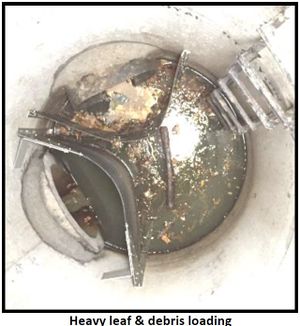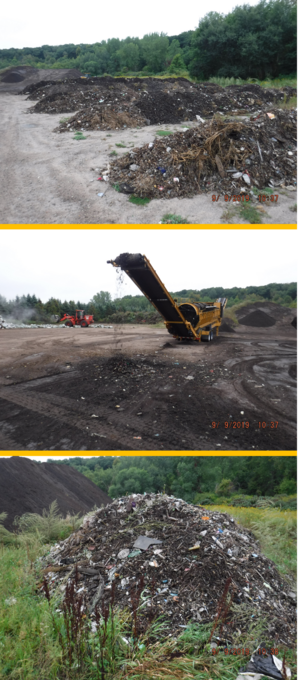
Guidance for managing sediment and wastes collected by pretreatment practices
This discussion focuses on pretreatment practices. Pretreatment reduces maintenance and prolongs the lifespan of structural stormwater BMPs by removing trash, debris, organic materials, coarse sediments, and associated pollutants prior to entering structural stormwater BMPs. Implementing pretreatment devices also improves aesthetics by capturing debris in focused or hidden areas.
Because pretreatment practices remove material from stormwater runoff, they must be periodically cleaned to maintain their function. This page provides information on management of material collected in pretreatment practices, including disposal options.
For information on pretreatment, link here.
Contents
Types of practices
Below is a brief summary of the types of materials typically found in these practices.
- Catch basins. A catch basin is an inlet to a stormdrain system that typically includes a grate where stormwater enters the catch basin, and a basin to capture sediment, debris, and associated pollutants. They may also capture floatables and settle some solids. Catch basins act as pretreatment for other treatment practices by capturing large sediments.
- Grit chambers and oil/grit separators: Grit chambers are tanks designed to slow down water flow so that solids will settle out of the water. Oil/grit separators are underground storage tanks with three chambers designed to remove heavy particulates, floating debris and hydrocarbons from stormwater.
Description of material captured
The type of material collected in a pretreatment practice depends on the source of stormwater runoff. Primary constituents include sand, salt, leaves, and other litter and debris washed off streets, parking lots and sidewalks.
See the discussion below for results of sampling for materials collected by these practices.
Monitoring results
There is limited information for sampling of sediments and other materials captured by pretreatment practices. The Excel spreadsheet below summarizes results from sampling studies. NOTE: This spreadsheet may be updated periodically and includes a date at the top of the spreadsheet.
File:Pretreatment sampling data.xlsx
In general, concentrations of metals and organic pollutants are below levels of concern. The following bullets summarize results for these studies.
- Florida Department of Environmental Protection
- Examined street sweepings and catch basins
- Upper 95% confidence limit concentrations for metals were below Florida criteria except for arsenic in catch basins; and iron, aluminum, and Beta-BHC in street sweepings and catch basins.
- Upper 95% confidence limit concentrations of metals other than arsenic, iron, and aluminum were typically close to or more than an order of magnitude lower than Florida criteria
- Townsend, 2003 - street sweepings
- Average concentrations of metals other than arsenic were below residential criteria for Florida
- Maximum concentrations of metals exceeded residential criteria for arsenic, barium, chromium, copper, and lead
- Average concentrations of all metals were below industrial criteria for Florida
- Maximum concentrations of arsenic, chromium, and lead exceeded industrial criteria for Florida
- Townsend, 2003 - catch basins
- Average concentrations of metals other than arsenic were below residential criteria for Florida
- Maximum concentrations of metals exceeded residential criteria for arsenic, copper, and lead
- Average concentrations of all metals were below industrial criteria for Florida
- Maximum concentrations of arsenic and lead exceeded industrial criteria for Florida
- Townsend, 2003 - leaching studies for street sweepings and catch basins
- Average concentrations of nickel exceeded leaching criteria for Florida
- Maximum concentrations of lead exceeded leaching criteria for Florida
- Yu and Stopinski, 2001
- Concentrations of metals other than chromium were below criteria for Isolator and Stormceptor pretreatment devices. NOTE: the criteria for hexavalent chromium was used in this analysis
- City of Lakeville, Minnesota - street sweepings
- Concentrations of RCRA metals were below residential soil reference values
- No detections of metals for TCLP analysis
- DRO (diesel range organics) concentration (175 mg/kg) exceeded site screening criteria (10 mg/kg)
- Village of St. Anthony, Minnesota - street sweepings
- Concentrations of RCRA metals were below residential soil reference values
- DRO (diesel range organics) concentration (124 mg/kg) exceeded site screening criteria (10 mg/kg)
- Excel file with data on metal concentrations in street sweepings: File:Metals in street dirt-sweepings.xlsx
Comparisons of results from these studies with Minnesota criteria, maximum concentrations of all metals except arsenic and lead are below industrial soil reference values.
Disposal of collected material
Analysis of stormwater runoff and sediments collected by pretreatment practices indicate that "typical" concentrations of pollutants do not warrant testing and the material can be disposed at a permitted landfill.
The following steps are typically found in guidance for handling these materials.
- Remove the majority of water in the sump of the basin without disturbing the solid material below. The clear water may be discharged to one of the following.
- Sanitary system (with prior approval from local sewer authority)
- Curb and gutter
- Back into the storm sewer system as long as it is contained within the system during dry weather condition to ensure no discharge into surface water
- Applied to the ground adjacent to the catch basin (evenly distributed at a maximum rate of 250 gallons/acre/year)
- The remaining material may be handled in one of the following manners.
- The dewatered materials can be deposited at a permitted landfill.
- The dewatered materials can be reused. The following steps are recommended when the material is reused.
- The remaining liquid and solid may be screened to remove organic materials such as leaves, pine needles, branches, and grass cuttings. The organic materials can be composted.
- Coarse sand may be screened and stockpiled for future use.
- Screened soil may be reused for one of the following.
- Feedstock material for topsoil operations
- Fill in parks and recreational settings, provided it is covered with grass, sod, or other capping material
- Construction fill for industrial or commercial sites, roadways, or parking lots
- As the sub-grade beneath a paved municipal road or parking lot
- As aggregate in concrete or asphalt
- Landfill cover
Screening
Visual screening of water in a sump is recommended for the following.
- Odor
- Color
- Turbidity
- Floatables
- Deposits and staining
- Vegetation
- Structural damage
For more information on screening, link here
Testing
Testing is recommended for the following.
- Any facility or operation where the operator has knowledge that a potential hazardous waste has been placed in a sump or pit
- Any pretreatment practice receiving discharges from chemical storage areas
- Pretreatment practices receiving discharges from certain industrial or contaminated sites
Links
The following links generally align with the section heading, although there may be some overlap at a specific site. For a summary of our literature review, [File:Pretreatment waste disposal literature review.docx link here].
Catch basins
- STREET SWEEPINGS/STORMWATER BASINS AND CAR WASH PIT DISPOSAL - Iowa Department of Natural Resources
- Sump Waste Disposal Guidelines - South Dakota Department of Environment and Natural Resources
- Maintaining Catch Basins - City of Portland Environmental Services
- Management of Catch Basin Cleanings - Massachusetts Department of Environmental Protection
- Catch Basin Cleaning Activities Guidance Document - Michigan Department of Environmental Quality
- Position Paper Street Sweeping, Stormwater Sediment and Catch Basin Disposal - Florida Stormwater Association
- GUIDELINE FOR MUNICIPAL MANAGEMENT PRACTICES FOR STREET SWEEPINGS & CATCH BASIN CLEANINGS - Connecticut Department of Environmental Protection
- Waste Disposal protocol - City of Wenatchee
Grit chambers, hydrodynamic separators
- Cleaning of Grit Chambers - MnDOT Office of Environmental Stewardship Environmental Investigation Unit
- TESTING OF ULTRA-URBAN STORMWATER BEST MANAGEMENT PRACTICES - Yu and Stopinski (2001)
- Stormwater O&M Fact Sheet - EPA
- Waste Disposal protocol - City of Wenatchee
Monitoring studies
- EVALUATION OF ANALYTICAL DATA CHARACTERIZING STREET SWEEPINGS, STORMWATER SEDIMENTS AND CATCH BASIN SEDIMENTS - Florida Department of Environmental Protection
- CHARACTERIZATION OF STREET SWEEPINGS , STORMWATER SEDIMENTS , AND CATCH BASIN SEDIMENTS , IN FLORIDA FOR DISPOSAL AND REUSE Final Report - Townsend, 2003.
- Characterization of roadway stormwater system residuals for reuse and disposal options. - Jang et. al,; Sci Total Environ. 2010 Mar 15;408(8):1878-87.
- CHARACTERIZATION OF STREET SWEEPINGS, STORMWATER SEDIMENTS, AND CATCH BASIN SEDIMENTS, IN FLORIDA FOR DISPOSAL AND REUSE - Florida Center for Solid and Hazardous Waste Management
- Portland Harbor: Characterizing and Managing Catch Basin and In-line Sediments - Oregon Department of Environmental Quality
- Catch Basin Inlet Cleaning Pilot Study: Final Report - City of San Diego
- Pollutant Dynamics of Pond Muck - Schueler (2000)
- TESTING OF ULTRA-URBAN STORMWATER BEST MANAGEMENT PRACTICES - Yu and Stopinski (2001)
Related pages
- Pretreatment selection tool
- Overview and methods of pretreatment
- Overviews for different types of pretreatment practices
- Information for specific types of pretreatment practices
- Design, construction, operation and maintenance specifications for pretreatment vegetated filter strips
- Pretreatment - Hydrodynamic separation devices
- Pretreatment - Screening and straining devices, including forebays
- Pretreatment - Above ground and below grade storage and settling devices
- Pretreatment - Filtration devices and practices
- Pretreatment - Other pretreatment water quality devices and practices
- To see the above pages as a single page, link here
Pretreatment sizing for basins and filters strips
Guidance for managing sediment and wastes collected by pretreatment practices
Tables
- Pretreatment tables - link to tabled information for pretreatment practices
- Hydrodynamic separator tables
- Screening and straining devices tables
- Above ground and below grade storage and settling tables
- Filtration tables
- Other water quality devices tables
Other information and links
This page was last edited on 17 January 2023, at 15:00.


